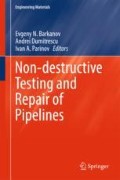Abstract
This chapter is devoted to a numerical study of the vibration-based damage detection (VBDD) techniques of steel pipeline systems. VBDD techniques are thought to be worldwide non-destructive evaluation (NDE) techniques. VBDD techniques are based on detecting damage by using changes in the dynamic features of a structure that were a result of the defect VBDD techniques have specific advantages over local NDE techniques. For example, VBDD techniques shortly estimate the state of the whole structure. Moreover, they have not restrictions to accessible components. Well-controlled numerical experiments of finite element model of steel pipeline system demonstrated that it is possible to reliably detect damage at different locations, as well as to locate VBDD techniques, applying relatively few sensors (strain gauges or accelerometers) and taking into account changes that happen to the essential vibration mode. Determination of eigenfrequencies and mode shapes for mechanical systems is one of the most important tasks, which allow receiving integrated information about the structure state. The aim of this chapter is to analyze the results of the vibration method for determining the degree of damage in pipeline system, and development of a software module for the damage localization in structures. In the result of this work, it was found, if mode shapes were well defined with a large number of measurement points, then the damage location could be determined with great accuracy, using any of the four VBDD techniques investigated. During this research, it was established that the probability of successful damage localization depends on the damage severity, the trials number. The latter is applied for getting the average mode shape, the distance between the support and the damage, the disposition of damage in respect to the nearest sensor, and the measurement errors magnitude. The method is offered for calculating the probability of successful detection and localization of the damage. It is based on the measured mode shapes repeatability. As a conclusion, this research results demonstrate that VBDD techniques are a perspective tool to monitor structural health of pipeline systems. However, while these methods are capable to detect effectively small-size defect under well-controlled conditions, a significant amount of challenging work should be performed before the methods can be applied to real structures.
The original version of the book was revised: Incorrect author names have been corrected. The erratum to the book is available at https://doi.org/10.1007/978-3-319-56579-8_28
Access this chapter
Tax calculation will be finalised at checkout
Purchases are for personal use only
References
E. Manoach, J. Warminski, L. Kloda, A. Teter, Numerical and experimental studies on vibration based methods for detection of damage in composite beams. Compos. Struct. 170, 26 (2017)
K. Padil, N. Bakhary, H. Hao, The use of a non-probabilistic artificial neural network to consider uncertainties in vibration-based-damage detection. Mech. Syst. Signal Process. 83, 194 (2017)
O. Abdeljaber, O. Avci, S. Kiranyaz, M. Gabbouj, D. Inman, Real-time vibration-based structural damage detection using one-dimensional convolutional neural networks. J. Sound Vib. 388, 154 (2017)
K. Chang, C. Kim, Modal-parameter identification and vibration-based damage detection of a damaged steel truss bridge. Eng. Struct. 122, 156 (2016)
W.R. Wickramasinghe, D.P. Thambiratnam, T. Chan, T. Nguyen, Vibration characteristics and damage detection in a suspension bridge. J. Sound Vib. 375, 254 (2016)
T. Yin, Q. Jiang, K. Yuen, Vibration-based damage detection for structural connections using incomplete modal data by Bayesian approach and model reduction technique. Eng. Struct. 132, 260 (2017)
F.L.M. dos Santos, B. Peeters, H. Van der Auweraer, L.C.S. Góes, W. Desmet, Vibration-based damage detection for a composite helicopter main rotor blade. Case Stud. Mech. Syst. Signal Process. 3, 22 (2016)
Z. Zhou, Vibration-Based Damage Detection of Bridge Superstructures. (VDM Verlag, Germany, 2008), p. 55
O.S. Salawu, Bridge assessment using forced-vibration testing. Am. Soc. Civ. Eng. 32 (1995)
O.S. Salawu, C. Williams, Damage location using vibration mode shapes. in Proceedings of the 12th International Modal Analysis Conference, vol. 933 (Society of Experimental Mechanics, Bethel, 1994)
O.S. Salawu, Detection of structural damage through changes in frequency: a review. Eng. Struct. 19(9), 718 (1997)
S.W. Doebling, C.R. Farrar, M.B. Prime, A summary review of vibration-based damage identification methods. Shock and Vibration Digest 30(2), 91 (1998)
P. Cawley, R.D. Adams, The location of defects in structures from measurements of natural frequencies. J. Strain Anal. Eng. Des. 14(2), 49 (1979)
B. Peeters, System Identification and Damage Detection in Civil Engineering, Ph.D. Thesis, Department of Civil Engineering, Katholieke Universiteit Leuven, Leuven, Belgium, 2000
Z. Zhou, L.D. Wegner, B.F. Sparling, Vibration-based detection of small-scale damage on a bridge deck. J. Struct. Eng. 133(9), 1257 (2007)
P. Hajela, F.J. Soeiro, Recent developments in damage detection based on system identification methods. Structural Optimization 2(1), 1 (1990)
J.R. Casas, A.C. Aparicio, Structural damage identification from dynamic-test data. J. Struct. Eng. 120(8), 2437 (1994)
B. Peeters, J. Maeck, G. De Roeck, Vibration-based damage detection in civil engineering: excitation sources and temperature effects. Smart Mater. Struct. 10(3), 518 (2001)
Acknowledgements
The work is performed under the support of the Russian Foundation for Basic Research (RFBR) No. 15-01-04995.
Author information
Authors and Affiliations
Corresponding author
Editor information
Editors and Affiliations
Rights and permissions
Copyright information
© 2018 Springer International Publishing AG
About this chapter
Cite this chapter
Lyapin, A.A., Shatilov, Y.Y. (2018). Vibration-Based Damage Detection of Steel Pipeline Systems. In: Barkanov, E., Dumitrescu, A., Parinov, I. (eds) Non-destructive Testing and Repair of Pipelines. Engineering Materials. Springer, Cham. https://doi.org/10.1007/978-3-319-56579-8_5
Download citation
DOI: https://doi.org/10.1007/978-3-319-56579-8_5
Published:
Publisher Name: Springer, Cham
Print ISBN: 978-3-319-56578-1
Online ISBN: 978-3-319-56579-8
eBook Packages: EngineeringEngineering (R0)

